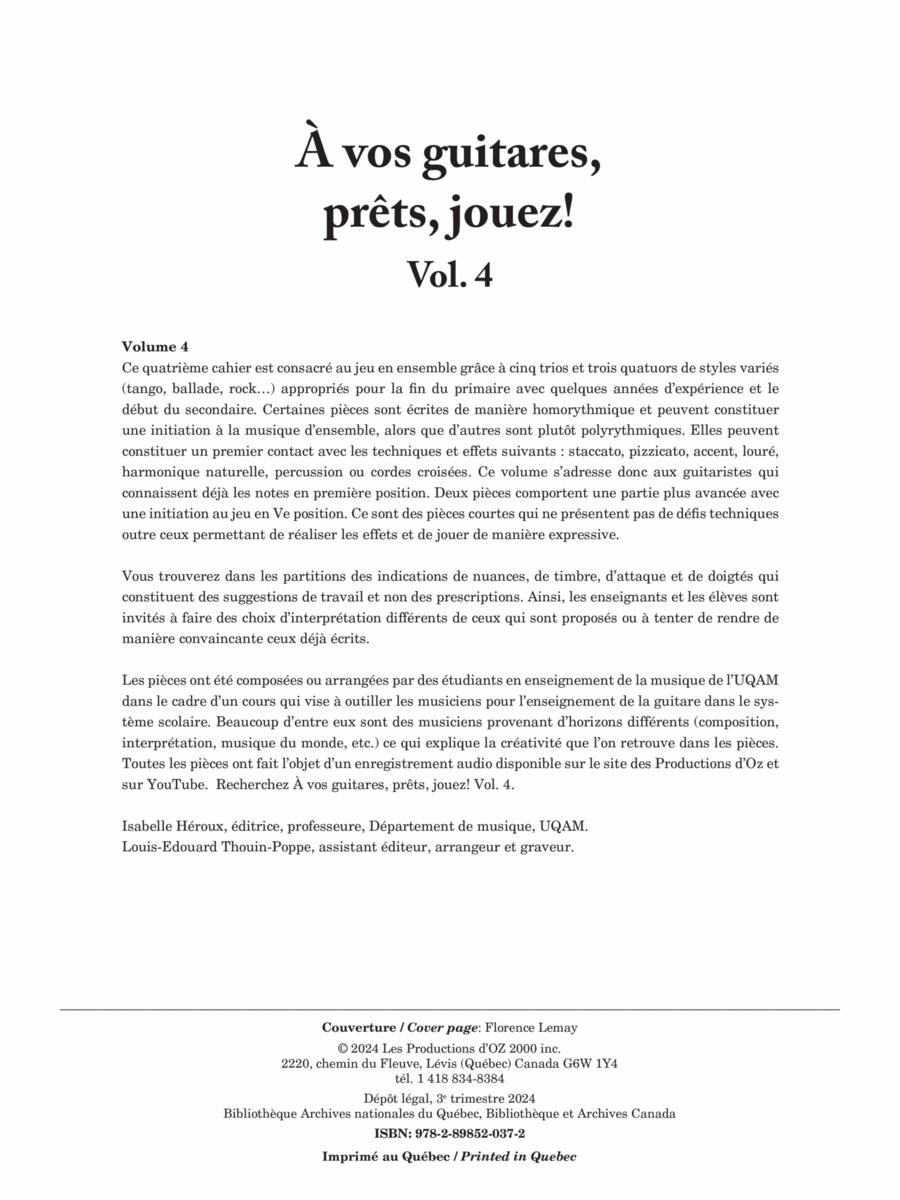This fourth booklet is dedicated to ensemble playing through five trios and three quartets of various styles (tango, ballad, rock, etc.) appropriate for the end of primary school with a few years of experience and the beginning of secondary school. Some pieces are written in a homorhythmic manner and can constitute an introduction to ensemble music, while others are rather polyrhythmic. They can constitute a first contact with the following techniques and effects: staccato, pizzicato, accent, louré, natural harmonic, percussion or crossed strings. This volume is therefore intended for guitarists who already know the notes in first position. Two pieces include a more advanced part with an introduction to playing in 5th position. These are short pieces that do not present technical challenges other than those allowing you to achieve the effects and play expressively.You will find in the scores indications of nuances, timbre, attack and fingerings which constitute suggestions for work and not prescriptions. Teachers and students are therefore invited to make interpretation choices different from those proposed or to try to convincingly render those already written.The pieces were composed or arranged by UQAM music education students as part of a course aimed at equipping musicians for teaching guitar in the school system. Many of them are musicians from different backgrounds (composition, performance, world music, etc.), which explains the creativity found in the pieces. All the pieces have been the subject of an audio recording available on the Productions d’Oz website and on YouTube. Search for À vos guitares, prêt, joue! Vol. 4.Isabelle Héroux, editor, professor, Department of Music, UQAM.Louis-Edouard Thouin-Poppe, assistant editor, arranger and engraver.Ce quatrième cahier est consacré au jeu en ensemble grâce à cinq trios et trois quatuors de styles variés (tango, ballade, rock…) appropriés pour la fin du primaire avec quelques années d’expérience et le début du secondaire. Certaines pièces sont écrites de manière homorythmique et peuvent constituer une initiation à la musique d’ensemble, alors que d’autres sont plutôt polyrythmiques. Elles peuvent constituer un premier contact avec les techniques et effets suivants : staccato, pizzicato, accent, louré, harmonique naturelle, percussion ou cordes croisées. Ce volume s’adresse donc aux guitaristes qui connaissent déjà les notes en première position. Deux pièces comportent une partie plus avancée avec une initiation au jeu en Ve position. Ce sont des pièces courtes qui ne présentent pas de défis techniques outre ceux permettant de réaliser les effets et de jouer de manière expressive. Vous trouverez dans les partitions des indications de nuances, de timbre, d’attaque et de doigtés qui constituent des suggestions de travail et non des prescriptions. Ainsi, les enseignants et les élèves sont invités à faire des choix d’interprétation différents de ceux qui sont proposés ou à tenter de rendre de manière convaincante ceux déjà écrits.Les pièces ont été composées ou arrangées par des étudiants en enseignement de la musique de l’UQAM dans le cadre d’un cours qui vise à outiller les musiciens pour l’enseignement de la guitare dans le système scolaire. Beaucoup d’entre eux sont des musiciens provenant d’horizons différents (composition, interprétation, musique du monde, etc.) ce qui explique la créativité que l’on retrouve dans les pièces. Toutes les pièces ont fait l’objet d’un enregistrement audio disponible sur le site des Productions d’Oz et sur YouTube. Recherchez À vos guitares, prêts, jouez! Vol. 4.Isabelle Héroux, éditrice, professeure, Département de musique, UQAM.Louis-Edouard Thouin-Poppe, assistant éditeur, arrangeur et graveur
